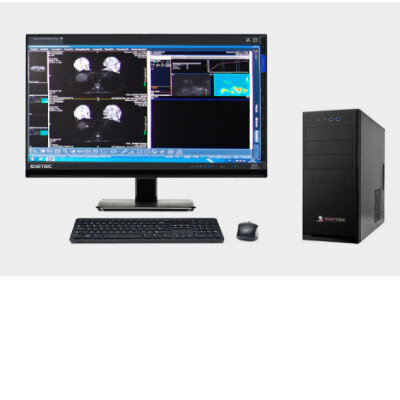Virtual DICOM Software Developed for Distribution of Patient Images and Results 
|
By MedImaging International staff writers Posted on 13 May 2014 |
Novel hardware and software has been designed to provide healthcare facilities with a streamlined, fast, and secure way to distribute Digital Imaging and Communications in Medicine (DICOM) images to referring physicians, patients, and other facilities.
SST Group (Santa Clara, CA, USA), a provider of medical disc publishing solutions, picture archiving and communication system (PACS) software, and accessories, announced the launch of the DICOM Virtual Media Creator (DVM-EZ). With DVM-EZ, sharing protected health information (PHI), including DICOM images, is as simple as sending an email. The receiver simply decrypts the package using a secure password and the virtual media containing the PHI information opens on the user’s desktop. All DVM-EZ activity is recorded in audit logs for HIPAA (Health Insurance Portability and Accountability Act of 1996) compliance.
The software’s intuitive, browser-based user interface provides on-demand virtual media creation for DICOM studies and other PHI elements from anywhere on a network. Images, reports, and electronic medical record (EMR) data are bundled with a comprehensive DICOM viewer, encrypted and sent via secure connection to the referring physician, patient, or medical facility. There is no enrollment required or per study fee charged for a user to receive studies.
“SST has been able to leverage its expertise in the medical CD burner category to develop and bring the DVM-EZ to market,” explained Richard Murphy, president SST Group, Inc. “DVM-EZ is designed to provide a secure, cost-effective delivery method for DICOM images and PHI data. DVM-EZ gives radiology departments the ability to electronically send patient images and PHI data to patients and referring physicians without any per use or subscription fees, while still adhering to the strict HIPAA compliance requirement for PHI data.”
SST Group, Inc. is a developer of medical disc publishing solutions, PACS software and accessories. From simple data storage to specialized DICOM medical solutions, products include hardware and software systems to help store, organize, and share medical images within PACS systems.
Related Links:
SST Group
SST Group (Santa Clara, CA, USA), a provider of medical disc publishing solutions, picture archiving and communication system (PACS) software, and accessories, announced the launch of the DICOM Virtual Media Creator (DVM-EZ). With DVM-EZ, sharing protected health information (PHI), including DICOM images, is as simple as sending an email. The receiver simply decrypts the package using a secure password and the virtual media containing the PHI information opens on the user’s desktop. All DVM-EZ activity is recorded in audit logs for HIPAA (Health Insurance Portability and Accountability Act of 1996) compliance.
The software’s intuitive, browser-based user interface provides on-demand virtual media creation for DICOM studies and other PHI elements from anywhere on a network. Images, reports, and electronic medical record (EMR) data are bundled with a comprehensive DICOM viewer, encrypted and sent via secure connection to the referring physician, patient, or medical facility. There is no enrollment required or per study fee charged for a user to receive studies.
“SST has been able to leverage its expertise in the medical CD burner category to develop and bring the DVM-EZ to market,” explained Richard Murphy, president SST Group, Inc. “DVM-EZ is designed to provide a secure, cost-effective delivery method for DICOM images and PHI data. DVM-EZ gives radiology departments the ability to electronically send patient images and PHI data to patients and referring physicians without any per use or subscription fees, while still adhering to the strict HIPAA compliance requirement for PHI data.”
SST Group, Inc. is a developer of medical disc publishing solutions, PACS software and accessories. From simple data storage to specialized DICOM medical solutions, products include hardware and software systems to help store, organize, and share medical images within PACS systems.
Related Links:
SST Group
Latest Imaging IT News
- New Google Cloud Medical Imaging Suite Makes Imaging Healthcare Data More Accessible
- Global AI in Medical Diagnostics Market to Be Driven by Demand for Image Recognition in Radiology
- AI-Based Mammography Triage Software Helps Dramatically Improve Interpretation Process
- Artificial Intelligence (AI) Program Accurately Predicts Lung Cancer Risk from CT Images
- Image Management Platform Streamlines Treatment Plans
- AI-Based Technology for Ultrasound Image Analysis Receives FDA Approval
- AI Technology for Detecting Breast Cancer Receives CE Mark Approval
- Digital Pathology Software Improves Workflow Efficiency
- Patient-Centric Portal Facilitates Direct Imaging Access
- New Workstation Supports Customer-Driven Imaging Workflow
Channels
Radiography
view channel
Novel Breast Imaging System Proves As Effective As Mammography
Breast cancer remains the most frequently diagnosed cancer among women. It is projected that one in eight women will be diagnosed with breast cancer during her lifetime, and one in 42 women who turn 50... Read more
AI Assistance Improves Breast-Cancer Screening by Reducing False Positives
Radiologists typically detect one case of cancer for every 200 mammograms reviewed. However, these evaluations often result in false positives, leading to unnecessary patient recalls for additional testing,... Read moreMRI
view channel
PET/MRI Improves Diagnostic Accuracy for Prostate Cancer Patients
The Prostate Imaging Reporting and Data System (PI-RADS) is a five-point scale to assess potential prostate cancer in MR images. PI-RADS category 3 which offers an unclear suggestion of clinically significant... Read more
Next Generation MR-Guided Focused Ultrasound Ushers In Future of Incisionless Neurosurgery
Essential tremor, often called familial, idiopathic, or benign tremor, leads to uncontrollable shaking that significantly affects a person’s life. When traditional medications do not alleviate symptoms,... Read more
Two-Part MRI Scan Detects Prostate Cancer More Quickly without Compromising Diagnostic Quality
Prostate cancer ranks as the most prevalent cancer among men. Over the last decade, the introduction of MRI scans has significantly transformed the diagnosis process, marking the most substantial advancement... Read moreUltrasound
view channel
Deep Learning Advances Super-Resolution Ultrasound Imaging
Ultrasound localization microscopy (ULM) is an advanced imaging technique that offers high-resolution visualization of microvascular structures. It employs microbubbles, FDA-approved contrast agents, injected... Read more
Novel Ultrasound-Launched Targeted Nanoparticle Eliminates Biofilm and Bacterial Infection
Biofilms, formed by bacteria aggregating into dense communities for protection against harsh environmental conditions, are a significant contributor to various infectious diseases. Biofilms frequently... Read moreNuclear Medicine
view channel
New SPECT/CT Technique Could Change Imaging Practices and Increase Patient Access
The development of lead-212 (212Pb)-PSMA–based targeted alpha therapy (TAT) is garnering significant interest in treating patients with metastatic castration-resistant prostate cancer. The imaging of 212Pb,... Read moreNew Radiotheranostic System Detects and Treats Ovarian Cancer Noninvasively
Ovarian cancer is the most lethal gynecological cancer, with less than a 30% five-year survival rate for those diagnosed in late stages. Despite surgery and platinum-based chemotherapy being the standard... Read more
AI System Automatically and Reliably Detects Cardiac Amyloidosis Using Scintigraphy Imaging
Cardiac amyloidosis, a condition characterized by the buildup of abnormal protein deposits (amyloids) in the heart muscle, severely affects heart function and can lead to heart failure or death without... Read moreGeneral/Advanced Imaging
view channel
New AI Method Captures Uncertainty in Medical Images
In the field of biomedicine, segmentation is the process of annotating pixels from an important structure in medical images, such as organs or cells. Artificial Intelligence (AI) models are utilized to... Read more.jpg)
CT Coronary Angiography Reduces Need for Invasive Tests to Diagnose Coronary Artery Disease
Coronary artery disease (CAD), one of the leading causes of death worldwide, involves the narrowing of coronary arteries due to atherosclerosis, resulting in insufficient blood flow to the heart muscle.... Read more
Novel Blood Test Could Reduce Need for PET Imaging of Patients with Alzheimer’s
Alzheimer's disease (AD), a condition marked by cognitive decline and the presence of beta-amyloid (Aβ) plaques and neurofibrillary tangles in the brain, poses diagnostic challenges. Amyloid positron emission... Read more.jpg)
CT-Based Deep Learning Algorithm Accurately Differentiates Benign From Malignant Vertebral Fractures
The rise in the aging population is expected to result in a corresponding increase in the prevalence of vertebral fractures which can cause back pain or neurologic compromise, leading to impaired function... Read moreIndustry News
view channel
Bayer and Google Partner on New AI Product for Radiologists
Medical imaging data comprises around 90% of all healthcare data, and it is a highly complex and rich clinical data modality and serves as a vital tool for diagnosing patients. Each year, billions of medical... Read more



















